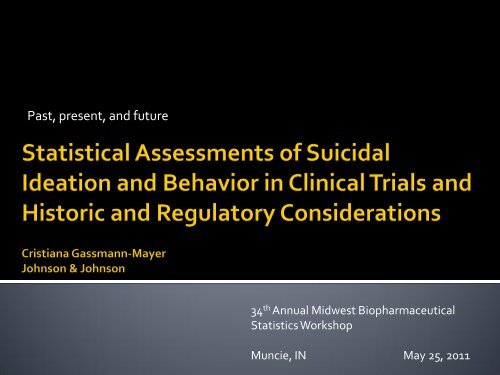Past, present, and future - MBSW Online
Past, present, and future - MBSW Online
Past, present, and future - MBSW Online
Create successful ePaper yourself
Turn your PDF publications into a flip-book with our unique Google optimized e-Paper software.
<strong>Past</strong>, <strong>present</strong>, <strong>and</strong> <strong>future</strong>34 th Annual Midwest BiopharmaceuticalStatistics WorkshopMuncie, IN May 25, 2011
• Cristiana Gassmann-Mayer is an employee ofJohnson & Johnson• The views <strong>and</strong> comments <strong>present</strong>ed here a solelythose of the <strong>present</strong>er <strong>and</strong> not necessarilyre<strong>present</strong>ative of those ofJohnson & Johnson or PhRMA organization• Several slides are adapted from the <strong>present</strong>ationto the FDA of April 4, 2011 (courtesy of MaryNilsson, Eli Lilly)Muncie, IN May 25, 2011 C. Gassmann-Mayer Johnson & Johnson 2
• Research question in clinical trials• Terminology• General background• Role of statisticians• Data collection: from retrospective toprospective scales• Statistical concepts <strong>and</strong> remaining areasfor debate• ConclusionsMuncie, IN May 25, 2011 C. Gassmann-Mayer Johnson & Johnson 3
Muncie, IN May 25, 2011 C. Gassmann-Mayer Johnson & Johnson 4
Is suicidalitythe right term ?Muncie, IN May 25, 2011 C. Gassmann-Mayer Johnson & Johnson5
• Avoid the term suicidality• In favor of more clinically meaningful <strong>and</strong>specific terms such as :• “suicidal ideation”• “suicidal behavior”• “completed suicides” etc.Meyer et al. (2010)SuicidalityMuncie, IN May 25, 2011 C. Gassmann-Mayer Johnson & Johnson6
Where we wereWhere we areWhere we are goingWho we areMuncie, IN May 25, 2011 C. Gassmann-Mayer Johnson & Johnson 7
• Last 2 decades• Early 1990’s : SSRI’s in adults with depression• 2002-2008 SSRIs in pediatric population<strong>and</strong> anti-epileptics, treatments of psychiatrydisorders, smoking cessation therapy, obesity,anti-allergy, etc.• Retrospective assessment of adverse eventsdata resulted in multiple label changes <strong>and</strong> black box warning• 2007• Dr. Kelly Posner <strong>and</strong> U of Columbia : Columbia- ClassificationAlgorithm of Suicide Assessment (C-CASA)Muncie, IN May 25, 2011 C. Gassmann-Mayer Johnson & Johnson8
• 2008- 2009• PhRMA* Working group: consensuson the assessment, analysis <strong>and</strong>reporting of suicide-related data• 2009• PhRMA white paper tothe FDA in January 2009• 2009-2010• Statistical sub-team continuedworking independently of PhRMA* Pharmaceutical Research <strong>and</strong> Manufacturers of AmericaMuncie, IN May 25, 2011 C. Gassmann-Mayer Johnson & Johnson9
Current Sub-Team of the original PhRMA WG:• Cristiana Gassmann-Mayer (J&J) – leader• Mary Nilsson (Eli Lilly) – co-lead analysis guideline• Shailaja Suryawanshi (Merck) - co-lead analysis guideline• Kaihong Jiang (Sanofi-Aventis)• Paul McSorley (GSK)• Ramin Arani (previously BMS, now Astellas Inc.)• Sarah DuBrava (Pfizer)• David Webb (previously Eli Lilly, now Dow AgroSciences)Previous participants in the first year:• Suna Barlas (Wyeth)• John Polzer (Eli Lilly)Muncie, IN May 25, 2011 C. Gassmann-Mayer Johnson & Johnson 10
• September 2010• FDA Draft Clinical <strong>and</strong> Medical Guidance on “Suicidality:Prospective Assessment of Occurrence in Clinical Trials”http://www.fda.gov/downloads/Drugs/GuidanceComplianceRegulatoryInformation/Guidances/UCM225130.pdfMuncie, IN May 25, 2011 C. Gassmann-Mayer Johnson & Johnson11
• FDA draft guidance includes:• Emphasis on using prospective suicide scales that map to theC-CASA system• Support to the C-SSRS instrumentMuncie, IN May 25, 2011 C. Gassmann-Mayer Johnson & Johnson12
C-CASA=classification system1. Completed Suicide Completed Suicide2. Suicide Attempt Actual Attempt3. Preparatory Actions Toward Imminent SuicidalBehaviorC-SSRS=prospective questionnaire-Interrupted Attempt-Aborted Attempt-Preparatory Acts or Behavior4. Suicidal Ideation 1. Wish to Die2. Active Suicidal Thought3. Active Suicidal Thought with Method4. Active Suicidal Thought with Intent5. Active Suicidal Thought with Plan <strong>and</strong> Intent7. Non-suicidal Self-injurious Behavior Non-suicidal Self-injurious BehaviorOther Categories Become Obsolete with Prospective Data Collection5. Self-injurious Behavior, Intent Unknown aN/A- Unknowns are eliminated with prospective data6. Not Enough Information: Death acollection a9. Not Enough Information: Non-Death a8. Other (Accident; Psychiatric; Medical) N/A: No indication of suicidal ideation or behavioraThe C-CASA codes #5,6,9 were created only to make sense of limitations of retrospective adverse events.Muncie, IN May 25, 2011 C. Gassmann-Mayer Johnson & Johnson13
• FDA draft guidance• Includes note that the analytical issues will beaddressed in separate guidancehttp://www.fda.gov/downloads/Drugs/GuidanceComplianceRegulatoryInformation/Guidances/UCM225130.pdfMuncie, IN May 25, 2011 C. Gassmann-Mayer Johnson & Johnson14
• Since 2009The statistical sub team worked on:• A manuscript on “Clinical <strong>and</strong> Statistical Assessment ofSuicidal Ideation & Behavior in Pharmaceutical Trials”(accepted May 2011)• An industry Scoring & Analysis Guide for data collected withthe C-SSRS scalewill be posted on Columbia University’s C-SSRS websitehttp://www.cssrs.columbia.edu/scales_cssrs.htmlMuncie, IN May 25, 2011 C. Gassmann-Mayer Johnson & Johnson15
• 4 th April 2011• F2F meeting of our group with the FDA to shareindustry guidelines on the proposed analyses <strong>and</strong>definitions on suicide-related data from C-SSRS• Future• More F2F scientific dialogues with the FDA (nextin September 2011)• Prospective collection of suicide data with a scaleas st<strong>and</strong>ard practice in clinical trials• FDA draft guidance on the statistical analysis ofsuicide-related dataMuncie, IN May 25, 2011 C. Gassmann-Mayer Johnson & Johnson16
• Contribute the scientific dialogue <strong>and</strong> promotecollaboration across industry, with the FDA, <strong>and</strong>academia on key safety domains <strong>and</strong> urgent researchquestions• Interact with the FDA as the guidance for industryfor suicidal events statistical analyses is beingdeveloped• Develop <strong>and</strong> contribute to scientific clinical/statistical documents [eg. White paper, clinical/statisticalpublications, C-SSRS Scoring & Analysis Guide]• Outline the remaining areas for debate <strong>and</strong> shapethe environmentMuncie, IN May 25, 2011 C. Gassmann-Mayer Johnson & Johnson17
• BE ACTIVE AND PROACTIVE• Collaborate with colleagues from other functions• Underst<strong>and</strong> clinical concepts, regulatory requirements, backgroundof the research question, <strong>and</strong> implications in using differentstatistical methodologies• Communicate clearly <strong>and</strong> use strong analytical skills• Network with colleagues across industry <strong>and</strong> regulatoryagencies• Stay up-to-date with the specific research field of interest• Both for the statistical <strong>and</strong> clinical aspects• Present <strong>and</strong> participate in workshops <strong>and</strong> symposia to illustrateideas <strong>and</strong> learn about new proposalsMuncie, IN May 25, 2011 C. Gassmann-Mayer Johnson & Johnson18
Collection of suicide-related dataIn the pastNowRetrospectiveSearch of AE terms <strong>and</strong> partialverbatim stringsProspectiveSuicide scales <strong>and</strong> instrumentsMuncie, IN May 25, 2011 C. Gassmann-Mayer Johnson & Johnson 19
• C-SSRS: Columbia-Suicidality Severity RatingScale• STS: Sheehan Suicidality Tracking Scale• HASS: Harkavy-Asnis Suicide Survey• SBQ-R: Suicidal Behaviors Questionnaire-Revised (SBQ-R)• ISST: InterSePT Scale for Suicidal Thinking• SSI: Scale for Suicide Ideation• BSI: Beck Suicide Ideation scale• Single item on Hamilton Depression RatingScale or the Beck Depression InventoryMuncie, IN May 25, 2011 C. Gassmann-Mayer Johnson & Johnson20
www.cssrs.columbia.edu/scales_cssrs.htmlColumbia-Suicide Severity Rating Scale:• Prospective counterpart of the C-CASA classificationscheme• Instrument designed to collect the:▪ Occurrence▪ Severity▪ Frequencyof both suicidal thoughts <strong>and</strong> behaviors• Outcomes for clinical management of safety▪ Suicidal behavior lethality rating (actual lethality/medicaldamage; potential lethality)▪ Suicidal ideation intensity rating (frequency, duration,controllability, deterrents, reason)Muncie, IN May 25, 2011 C. Gassmann-Mayer Johnson & Johnson21
Current Industry Proposal <strong>and</strong>Remaining Areas of DebateMuncie, IN May 25, 2011 C. Gassmann-Mayer Johnson & Johnson 22
• Suicide-related endpoints• Treatment emergence• History/Baseline• Assume suicidal ideation with all behaviors?• Suicidal behaviors as a hierarchy• Statistical analyses:• single trial• aggregated databasesMuncie, IN May 25, 2011 C. Gassmann-Mayer Johnson & Johnson 23
Suicidal IdeationSuicidal BehaviorSuicidal ideationor behaviora “yes” answer at any time duringtreatment to any one of the suicidalideation questionsa “yes” answer at any time duringtreatment to any one of the suicidalbehavior questionsa “yes” answer at any time duringtreatment to any one of the suicidalideation <strong>and</strong> behavior questionsNOTE:These definitions are based on C-SSRS; can be modified if usingother suicide scalesMuncie, IN May 25, 2011 C. Gassmann-Mayer Johnson & Johnson24
• Definition of treatment-emergence• TE definition varies across companies for theanalysis of adverse events in general• Recommend comparing max ideation duringtreatment with max during the pre-specified pretreatmentperiodSuicidal ideation <strong>present</strong> before treatment, notexperienced for some time, comes back during treatment It is not TE unless the category is higher/worseMuncie, IN May 25, 2011 C. Gassmann-Mayer Johnson & Johnson25
Muncie, IN May 25, 2011 C. Gassmann-Mayer Johnson & Johnson26
Recent HistoryAll prior History =LifetimeTime prior to treatment with studymedication closer to the start of the study.How close?All past history during the lifetime <strong>and</strong> priorto the subject’s study enrollmentLife timeX monthsprior tostudyBetweenScreening<strong>and</strong> BaselineStudyTreatmentScreening VisitBaseline VisitRecent historyAll prior history27Muncie, IN May 25, 2011 C. Gassmann-Mayer Johnson & Johnson
• Assume suicidal ideation with suicidal behavior?For example:Data Entry Suicidal ideation Suicidal behaviorSubject 12345NO XYESVisit 3• Impacts treatment emergence as wellYES?▪ If someone has a suicidal behavior during the pre-treatmentperiod, <strong>and</strong> has suicidal ideation during the treatment period,is that really TE suicidal ideation?• Area for debate !Muncie, IN May 25, 2011 C. Gassmann-Mayer Johnson & Johnson28
• Suicidal behaviors have no “natural” ordering• No implied hierarchyCompletedSuicide>Attempt>Interrupted>Aborted>PreparatoryBehavior?• Still contentious <strong>and</strong> questionable to analyzeinterpret the behaviors as possessing ordinalnatureMuncie, IN May 25, 2011 C. Gassmann-Mayer Johnson & Johnson29
• Be consistent with Sponsor st<strong>and</strong>ards; usesame statistical approach as for other safetyassessments• No adjustments for multiplicity typically in asingle trial• No inferential statistics except where indicated,otherwise exact tests; 95%CIs are recommended• Metrics: at least one analysis using odds ratio <strong>and</strong>one using risk differencePeto ORMantel-Haenszel risk differenceArcsine differenceMuncie, IN May 25, 2011 C. Gassmann-Mayer Johnson & Johnson30
• Time-to-event analyses• Time-to-event analyses may not be appropriatefor trials of short duration, when there are longtime intervals between scale collections, or due to“informative censoring” situations• Interpret with caution – Need to underst<strong>and</strong>assumptions• Exposure-adjusted analyses• Consider Exposure Adjusted Incidence Rates, fortaking into account variable duration of exposureMuncie, IN May 25, 2011 C. Gassmann-Mayer Johnson & Johnson31
• Follow the approach recommended in the SPERTCrowe et al (2009)• Use multiple approaches (eg, fixed effects vs r<strong>and</strong>omeffects)• Bayesian methods• Multi-item Gamma Poisson Shrinker• Three level hierarchicalmixture modelSPERT: Safety Planning Evaluation<strong>and</strong> Reporting TeamMuncie, IN May 25, 2011 C. Gassmann-Mayer Johnson & Johnson32
• Establish criteria for studies to include• Placebo-controlled studies only• Across indications <strong>and</strong> by indication• Consider separate meta-analysesfor considerable differences in duration• Routinely use Forest PlotsMuncie, IN May 25, 2011 C. Gassmann-Mayer Johnson & Johnson33
Include: Stratification by study Sensitivity analyses (eg. mixed effects vs fixed effects) Also studies with no events DerSimonian-Laird test (r<strong>and</strong>om effects) Exact meta-analytic approach that combines confidencedistributions to estimate the risk difference CI withoutcontinuity correction Pay attention to continuity correctionsSt<strong>and</strong>ard 0.5 correction is NOT recommendedOther corrections are preferredMuncie, IN May 25, 2011 C. Gassmann-Mayer Johnson & Johnson34
• No uniformly “best” method• Need for pre-specified safetyanalysis plans• Need for sensitivityanalyses• Need for cautionMuncie, IN May 25, 2011 C. Gassmann-Mayer Johnson & Johnson35
• Role of industry statisticians is key in SAFETY for:• developing new ideas to improve the statistical analyses <strong>and</strong>reporting of clinical safety data• analyzing data in the most appropriate way to ensureadequate <strong>and</strong> accurate estimate of the drug benefit/risk ratio• shaping <strong>and</strong> influencing the definition of “best practices” bycontributing to industry guidelines, white papers,publications <strong>and</strong> regulatory guidance• promoting <strong>and</strong> contributing to urgent scientific debates onkey statistical <strong>and</strong> clinical inter-related issues• collaborating with different groups (FDA, academia,pharmaceutical industry)Muncie, IN May 25, 2011 C. Gassmann-Mayer Johnson & Johnson36
Muncie, IN May 25, 2011 C. Gassmann-Mayer Johnson & Johnson37
Statistics may be defined as"a body of methods for makingwise decisions in the face ofuncertainty."~W.A. WallisMuncie, IN May 25, 2011 C. Gassmann-Mayer Johnson & Johnson 38
• Beck, A.T., Kovacs, M. & Weissman, A (1979). Assessment of suicidal intention:The Scale for Suicide Ideation. J Consult Clin Psychol 47, 343-52.• Clinical review: Relationship between antidepressant drugs <strong>and</strong> suicidality inadult; In: FDA Psychopharmacologic Drugs Advisory Committee BriefingDocument. (Department of Health <strong>and</strong> Human Services, Public Health Service, U.S. Food <strong>and</strong>Drug Administration Center for Drug Evaluation <strong>and</strong> Research; November 16,2006).• Coric, V., Stock, E.G., Pultz, J., Marcus, R. & Sheehan, D.V. (2009) Sheehansuicidality tracking scale (Sheehan-STS): Preliminary results from a multicenterclinical trial in generalized anxiety disorder. Psychiatry 6, 26-31.• Guidance for Industry, 2010,“Suicidality: Prospective Assessment of Occurrencein Clinical Trials’ , (Draft Guidance), U.S. Department of Health <strong>and</strong> HumanServices Food <strong>and</strong> Drug Administration Center for Drug Evaluation <strong>and</strong> Research(CDER) , September 2010, Clinical/Medical:http://www.fda.gov/downloads/Drugs/GuidanceComplianceRegulatoryInformation/Guidances/UCM225130.pdf• Harkavy Friedman, J.M. & Asnis (1989), G.M. Assessment of suicidal behavior: Anew instrument. Psychiatric Annals 19, 382-7.• Lindenmayer, J.P. et al.(2003) The InterSePT scale for suicidal thinking reliability<strong>and</strong> validity. Schizophrenia Res 63, 161-70.Muncie, IN May 25, 2011 C. Gassmann-Mayer Johnson & Johnson39
• Meyer, R.E. et al.(2010) Suicidality <strong>and</strong> risk of suicide--definition, drug safetyconcerns, <strong>and</strong> a necessary target for drug development: A brief report. J ClinPsychiatry 71, 1040-6.• Oquendo, M.A., Halberstam, B. & Mann, J.J.(2008) Columbia Suicide HistoryForm. In: H<strong>and</strong>book of Psychiatric Measures, Vol. 2nd (eds. Rush, J., First, M.B.<strong>and</strong> Black, D.) 241-2 (American Psychiatric Publishing, Inc;, Washington, D.C.• Osman, A., Bagge, C.L., Gutierrez, P.M., Konick, L.C., Kopper, B.A. & Barrios,F.X. (2001) The Suicidal Behaviors Questionnaire-Revised (SBQ-R): Validationwith clinical <strong>and</strong> nonclinical samples. Assessment 8, 443-54.• PhRMA White Paper, December 2008, on the Assessment of Suicidality ,December 19, 2008. On file upon request.• Posner, K., Oquendo, M., Gould, M., Stanley, B. & Davies (2007), M. ColumbiaClassification Algorithm of Suicide Assessment (C-CASA): Classification ofsuicidal events in the FDA's pediatric suicidal risk analysis of antidepressants. AmJ Psychiatry 164, 1035-43.• Posner, K., Melvin, G.A., Stanley, B., Oquendo, M.A. & Gould, M.(2007)Factors in the assessment of suicidality in youth. CNS Spectr 12, 156-62.• Stone, M. et al. (2009) Risk of suicidality in clinical trials of antidepressants inadults: analysis of proprietary data submitted to US Food <strong>and</strong> DrugAdministration. BMJ 339, b2880.Muncie, IN May 25, 2011 C. Gassmann-Mayer Johnson & Johnson40
• Berlin <strong>and</strong> Colditz (1999). The role of meta-analysis in the regulatory process forfoods, drugs, <strong>and</strong> devices. JAMA; 281:830-834.• Berry, S. & Berry, D. (2004) Accounting for multiplicities in assessing drug safety:a three-level hierarchical mixture model. Biometrics 60, 418-26• Bradburn MJ, Deeks J, Berlin JA, <strong>and</strong> Localio AR (2007). Much ado aboutnothing: a comparison of the performance of meta-analytical methods with rareevents. Statistics in Medicine; 26:53-77• Breslow, N.E. & Day, N.E. Statistical method in cancer research; vol 1. TheAnalysis of Case Control Studies (Oxford University Press: 1980).• Crowe BJ, et al., (2009), Recommendations for safety planning, data collection,evaluation <strong>and</strong> reporting during drug, biologic <strong>and</strong> vaccine development: a reportof the safety planning, evaluation, <strong>and</strong> reporting team. Clin Trials; 6: 430-440.• DerSimonian, R. & Laird,(1986) N. Meta-analysis in clinical trials. Control ClinTrials 7, 177-88.• DuMouchell, W.(1999) Bayesian data mining in large frequency tables, with anapplication to the FDA spontaneous reporting system. Am Stat 53, 177-90.Muncie, IN May 25, 2011 C. Gassmann-Mayer Johnson & Johnson41
• Gassmann-Mayer C, et al., (2011), Clinical <strong>and</strong> Statistical Assessment of Suicidal Ideation<strong>and</strong> Behavior in Pharmaceutical Trials. Clinical Pharmacology & Therapeutics (accepted)• Greenl<strong>and</strong>, S. <strong>and</strong> Robins, J.M.(1985) Estimation of a common effect parameter fromsparse follow-up data. Biometrics, 41, 55-68.• Hall, D.B.(2000) Zero-inflated poisson <strong>and</strong> binomial regression with r<strong>and</strong>om effects: a casestudy. Biometrics 56, 1030-9.• Helena Chmura Kraemer (2009) , Events per person-time (incidence rate): A misleadingstatistic? Statist. Med• Higgins, JPT, et al. (2002) Quantifying heterogeneity in a meta-analysis. Statistics inMedicine; 21:1539-1558• ICH E9: Statistical Principles for Clinical Trials (1998). Available from URL:http://www.ich.org/cache/compo/475-272-1.html. Accessed Sept 29, 2008.• Liu, G.F., Wang, J., Liu, K. & Snavely, D.B.(2006) Confidence intervals for an exposureadjusted incidence rate difference with applications to clinical trials. Stat Med 25, 1275-86.• McCulloch, C.E. & Searle (2001), S.R. Generalized linear <strong>and</strong> mixed models (John Wiley &Sons: New York, 2001).• O’Neill RT (1988). Assessment of safety. Biopharmaceutical Statistics for Drug Development.Peace KE, ed. New York: Marcel Dekker;543–604.Muncie, IN May 25, 2011 C. Gassmann-Mayer Johnson & Johnson42
• Pintilie, M. Competing risks: a practical perspective (John Wiley & sons: West Sussex, Engl<strong>and</strong>,2006).• Proschan MA, Lan KKG, Wittes JT (2006). Statistical Methods for Monitoring Clinical Trials.Springer, New York.• Rucker G et al. (2009) Why add anything to nothing? The arcsine difference as a measureof treatment effect in meta-analysis with zero cells Statist. Med. 2009; 28:721–738.• Satagopan, J.M., Ben-Porat, L., Berwick, M., Robson, M., Kutler, D. & Auerbach (2004), A.D.A note on competing risks in survival data analysis. Brit J Cancer 91, 1229-35.• Smith TC, et al. (1995) Bayesian approaches to r<strong>and</strong>om-effects meta-analysis: a comparativestudy. Statistics in Medicine; 16:2685-2699.• Statistical review <strong>and</strong> evaluation: Antiepileptic drugs <strong>and</strong> suicidality. (U.S. Dept ofHealth <strong>and</strong> Human Services, FDA, Center for Drug Evaluation <strong>and</strong> Research, Office ofTranslational Sciences, Office of Biostatistics; 23 May 2008).• Stijnen, T., Hamza T.H., <strong>and</strong> Ozdemir P.(2010) R<strong>and</strong>om effects meta-analysis of eventoutcome in the framework of the generalized linear mixed model with applications in sparsedata. Statist. Med. 29, 3046-3067 .• Sutton AJ, <strong>and</strong> Abrams KR (2001) Bayesian methods in meta-analysis <strong>and</strong> evidence synthesis.Statistical Methods in Medical Research; 10:277-303.Muncie, IN May 25, 2011 C. Gassmann-Mayer Johnson & Johnson43
• Sutton, A.J., Cooper, N.J., Lambert, P.C., Jones, D.R., Abrams, K.R. & Sweeting (2002),M.J. Meta-analysis of rare <strong>and</strong> adverse event data. Expert Rev Pharmacoecon Outcomes Res2, 367-79.• Sweeting MJ, Sutton AJ, <strong>and</strong> Lambert PC (2004) What to add to nothing? Use <strong>and</strong>avoidance of continuity corrections in meta-analysis of sparse data. Statistics in Medicine;23:1351-1375.• Sweeting MJ, Sutton AJ, <strong>and</strong> Lambert PC (2006). Correction. Statistics in Medicine; 25:2700.• Tian L, Cai T, Pfeffer M, Piankov N, Cremieux P.Y., <strong>and</strong> Wei L.J. (2009) "Exact <strong>and</strong>efficient inference procedure for meta analysis <strong>and</strong> its application to the analysis ofindependent 2 by 2 tables with all available data but without artificial continuitycorrection". Biostatistics (Oxford, Engl<strong>and</strong>);10(2):275-81.• Warn DE, Thompson SG, <strong>and</strong> Spiegelhalter DJ (2002) Bayesian r<strong>and</strong>om effects metaanalysisof trials with binary outcomes: methods for the absolute risk difference <strong>and</strong>relative risk scales. Statistics in Medicine; 21:1601-1623.Muncie, IN May 25, 2011 C. Gassmann-Mayer Johnson & Johnson44




